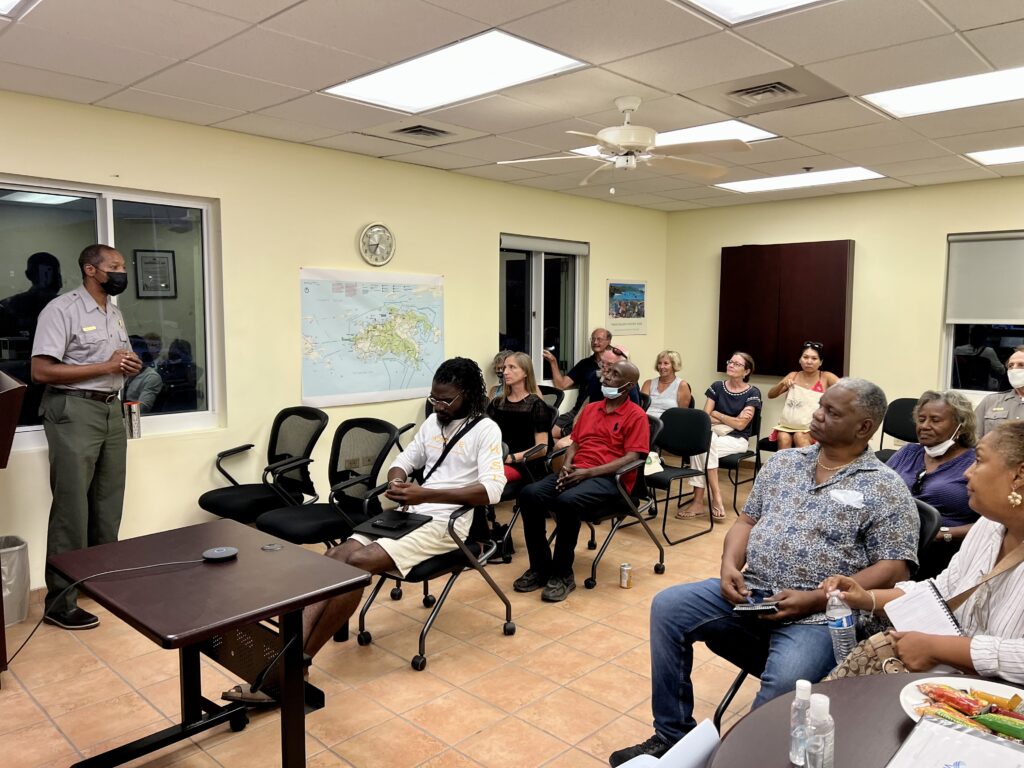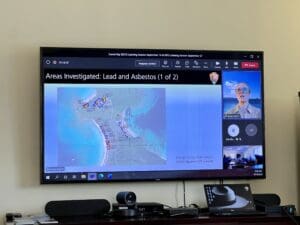
Additional sampling to test for toxic materials within the hurricane-ravaged Caneel Bay Resort on St. John has brought mixed results: tests conducted in November 2021 and February 2022 show that several suspected sites pose minimal danger to humans or wildlife, though asbestos was found in debris scattered throughout the property, which does present potentially serious health risks.
As part of the Comprehensive Environmental Response, Compensation, and Liability Act (CERCLA), the National Park Service has determined that this debris must be removed. The NPS is preparing a plan that is open for public comment through Oct. 12.
The findings from this latest round of tests were presented to the public at a meeting held at the Virgin Islands National Park visitors center in Cruz Bay on Wednesday evening; the meeting was also broadcast online through Microsoft Teams. Nearly 30 individuals attended.
The information from that meeting is now available online here, through the document titled 2022 Caneel Bay EECA Addendum report Draft Final.pdf. Members of the public can also register their comments at this site. Hard copies of the report can be viewed Monday through Friday from 9 am to 1:30 p.m. at the Visitors Center in Cruz Bay.
Who pays for the cost of cleanup?

The cost of removing toxic materials found prior to this most recent report was estimated to be around $6 million. Wednesday’s report stated that additional costs for removal of the asbestos might be $500,000, although “actual costs are expected to range from 30 percent below to 50 percent above the costs presented.”
Exactly who will pay for these costs, now and over time, is unclear. The NPS hopes to tap a federal source of funding while that answer is being determined.
“We have a Central Hazard Fund under the Department of the Interior, and we have put in a request,” said Nigel Fields, superintendent of the Virgin Islands National Park. “We have started to spend funds. Under CERCLA, we can recover the costs from the potential responsible parties.”
Kelly Kachurak, the federal government lead for the Contaminated Site Team, said, “The responsible parties have not yet been identified.” She will be working with the NPS’s legal team to determine who they are, and an action memorandum will be finalized.
“Once we move forward with the action memorandum, that (plan) establishes the framework for negotiations with potential responsible parties,” said Fields. “We will convey the information we found to the operator (of the resort) to give the operator a sense of what concerns and risks there might be.”
The matter is complicated. According to an NPS news release, “Caneel Bay currently operates under a retained use estate (RUE), a unique arrangement crafted by Laurance S. Rockefeller in 1983, setting aside the 150-acre resort for independent operation and management within Virgin Islands National Park without NPS oversight. The RUE expires on September 30, 2023.”
Caneel Bay Resort has had several “owner operators” since the resort was developed in 1956, so liability may be shared. Since 2004, the resort has been operated by CBI Acquisitions LLC, which has had a somewhat troubled relationship with the National Park Service.
Since 2017, the resort has remained closed as a hotel although a restaurant, beach bar, and water production plant have continued to operate on the property at various times. Some of the 166 guest units remain intact, but almost all beachfront units have been destroyed.
Damaged Buildings are Not Part of the Asbestos Clean-Up Plan
Some meeting-goers on Wednesday were surprised to learn that although the majority of the newer overnight units were constructed with asbestos-containing materials, they are not included in the current clean-up plan.
However, the current plan does include the removal of loose debris which contains asbestos as part of the CERCLA process because the asbestos in this debris is friable, meaning that it can break down and diffuse harmful particles into the environment.
The asbestos in the intact and semi-intact structures is less likely to cause harm unless another storm comes, leading to further damage from exposure to the environment, the report said.
Furthermore, underground pipes containing asbestos may end up being less of a threat to the environment if the pipes remain buried, according to officials.
The report also stated, “Of the suspected materials sampled (in scattered debris and structures,) 19 separate materials were confirmed to contain asbestos, including roofing, window glazing, window and door caulk, joint compound, glue, tiles … and asbestos-cement pipes were found in various buildings.”
Materials containing asbestos must be removed by a certified contractor and taken off island, most likely to Florida, where they can be disposed of safely.
The presence of asbestos in the buildings that remain at Caneel will be addressed later under another process, The Clean Air Act National Emissions Standards for Hazardous Air Pollutants (NESHAP).
“The buildings will be addressed in the redevelopment process,” said Kachurak.
Future of Caneel Bay Property Still Undecided
At Wednesday’s meeting, Fields said the Park Service expects to have a decision by Oct. 1, 2023 when the current operating agreement with EHI/CBIA, its present operator, expires. If the Park Service decides to allow the resort to be rebuilt, the new operator may take on some of the costs of demolition and removal of hazardous materials.
The National Park Service has been investigating the possibility of contamination since 2012.
Wednesday’s report also detailed the presence of lead-based paint used at the resort, but “where LBP was identified, it was generally in fair condition with only a few observed areas of limited peeling. Soil testing results did not indicate lead from peeling paint is being released to the environment. Therefore, NPS concluded that a response action for LBP under CERCLA is not currently required,” according to the document.
The NPS will hold a second meeting designed to be a listening session on Tuesday, Sept. 27 at 5:30 p.m. That meeting will also be held at the visitors center in Cruz Bay and online through Microsoft Teams.





